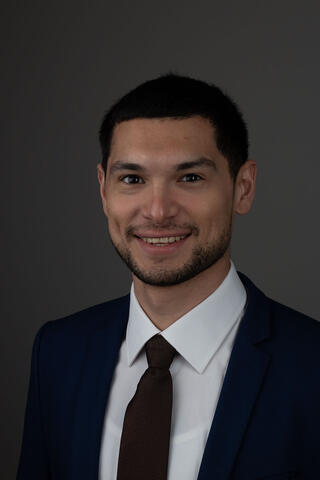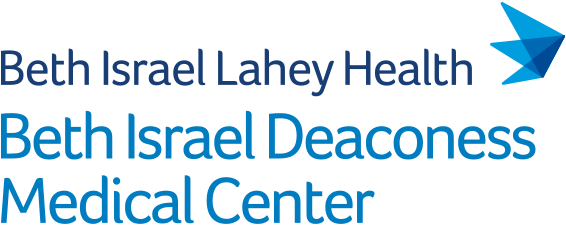
Frank Medina is a third-year student at the University of Chicago's Pritzker School of Medicine and a member of the 2025 Sarnoff Fellowship Program, which offers a select cohort of talented medical students the opportunity to complete a year of intensive biomedical research at a U.S. facility of their choosing.
Frank chose to spend his research year at the Smith Center, where he began work under the mentorship of Dr. Secemsky and Dr. Robert Yeh in June 2024. Over the past year, Frank has engaged in fruitful collaboration with his mentors and other research fellows -- he has presented his work on IVUS and IVI/IP at two national conferences and is currently preparing several papers for publication.
Before he returns to Chicago for his final year of medical school, we asked Frank to reflect on his path to medicine and his time at the Smith Center:
- What sparked your interest in medicine? Why cardiology?
My first job in high school was as a physical therapy rehab aid. I loved being an active agent in the healing journey of patients, and the science behind it fascinated me. When I started college, as a first-gen student, I didn’t quite yet know what my path would be. As I explored future careers in healthcare, I was also actively involved in community advocacy work. The more I explored medicine, the more the role of a physician seemed to perfectly fit my interests: advocacy and patient care.
My interest in cardiology began during the summer after my junior year of college completing a medicine pathway program at the Pritzker School of Medicine. I was mentored by an interventional cardiologist where I shadowed him in the cath lab while working on clinical research projects. From there, my interest grew. From working on clinical trials in heart failure during my gap years after college to caring for patients on the wards during my third year of medical school, cardiology felt like it would be my path forward toward making a meaningful impact in the lives of patients and my community. I love the patient care in cardiology as well as the avenues of research in the field.
- Why did you choose to come work with Dr. Secemsky? What drew you to the Smith Center?
When I started my Sarnoff mentorship search, several of my advisors recommended that I look at the Smith Center. One of the names recommended to me was Eric. From a quick search, I instantly saw the magnitude of the work he was leading in cardiovascular outcomes research. His work in both the coronary arteries and peripheral vasculature really excited me—specifically, his research into novel interventional procedures and investigating disparities in cardiovascular outcomes. That excitement was confirmed from our first meeting. As we connected over both being from the Chicagoland area, I felt that Eric really cared about my development as a person, a researcher, and future physician. I don’t think I could have made a better choice and I’m really grateful he decided to bring me on.
- What are a few ongoing or completed projects that you would like to highlight? What do you hope the impact of these projects will be?
With newer therapeutics and technologies, interventional cardiologists are completing more complex minimally invasive procedures called percutaneous coronary interventions (PCI) in patients with coronary artery disease. Intravascular imaging (IVI) and invasive physiology (IP) are some of the tools used, in addition to the standard 2D angiogram, to guide these procedures. IVI, a catheter-based imaging device, uses ultrasound or infrared light to look inside blood vessels. IP, a wire-based device, measures the blood flow inside arteries. IVI and IP complement conventional angiography by helping operators answer important but distinct questions to guide the procedure, such as: Which diseased artery should be intervened on and which should be treated medically? How well was the stent deployed? Were there any complications that are difficult to detect with the angiogram? While strong randomized data have shown improved outcomes with these adjunctive devices, their overall adoption remains low in the US.
Using Medicare claims data, we have completed projects researching utilization trends and outcomes with the use of IVI and IP, alone and together, during PCI. We are also examining sociodemographic disparities in access to these technologies. I hope the results of these projects will help influence the appropriate application of these devices in PCI and help push the needle forward in improving outcomes for patients. Simultaneously, I hope that highlighting the persistent and pervasive disparities in access, treatment, and outcomes may contribute to initiatives aimed to improve cardiovascular health equity.
- Reflecting on the time you’ve spent so far at the Smith Center, what have been one or two of your biggest takeaways from conducting work with this team?
The people here are genuine, brilliant, and humble. Everyone is so passionate about their work and while the research topics here are so diverse, they all share a common goal: to improve patient health and wellbeing. The Smith Center is a collaborative environment that pushes and challenges you to think beyond conventional research. It really is a special place.
- What do you hope to accomplish before you leave the Smith Center? What skills do you hope to bring back to your home institution?
Before I leave, I hope to complete the primary analysis of a new project that will explore prescription trends and outcomes of guideline medical therapy in patients with peripheral artery disease (PAD). PAD is widely underrecognized and portends poor outcomes for patients. I hope this study might help identify ways to improve the care that these patients receive.
When I return to medical school, I hope to harvest the clinical experiences I will gain and pair them with the skills of designing feasible ways to answer meaningful questions.
- Bonus: Favorite bit of cardiology vocabulary? Best cardiology pun? Fun fact?
Interventional cardiologists use a scoring system to classify coronary bifurcation lesions, which happens to be my last name: The Medina classification. Is my interest in interventional cardiology a coincidence or a prophecy?
